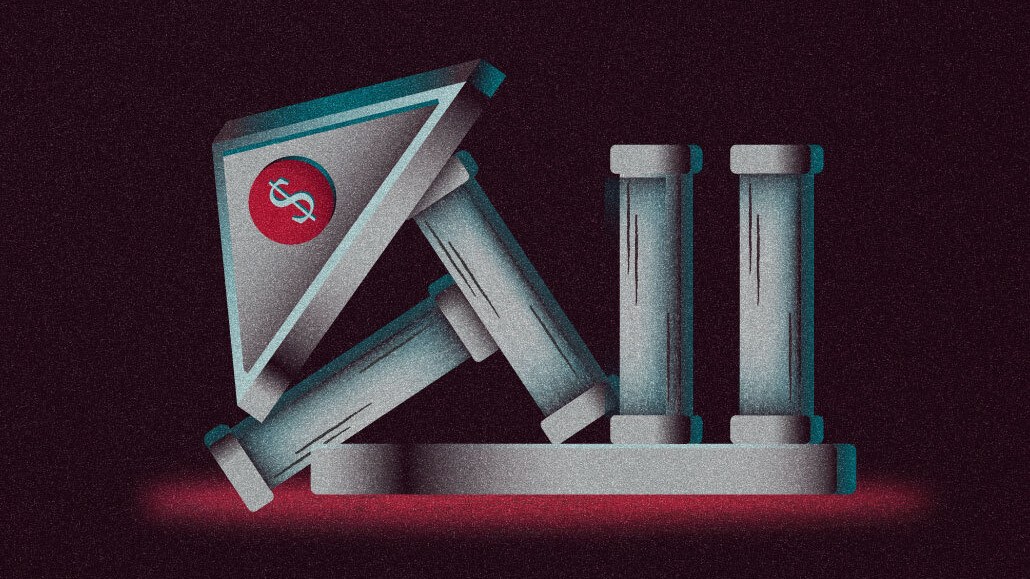
This article is a WTF explainer, in which we break down media and marketing’s most confusing terms. More from the series →
Whenever a company goes bust in ad tech, the term sequential liability tends to get bandied about.
The demise of MediaMath is no exception. It shows how sequential liability has become a necessary aspect for many companies in these challenging times. However, it also highlights the inherent unfairness in the ad tech industry, where the vulnerable entities are left to bear the brunt of unfavorable outcomes, while financially stronger players escape relatively unharmed.
What makes sequential liability so contentious? Let’s delve deeper to uncover the reasons behind its controversial nature.
WTF is sequential liability?
It’s the term used to describe why some companies are not required to pay those they owe money if they haven’t received payment for their product or service. Let’s consider a scenario of a line of dominos, where each domino represents a company in the supply chain. When one company in the line fails to pay its debts, it sets off a chain reaction, causing the other companies in the sequence to be exempted from paying their obligations further down the line.
In the case of MediaMath, the companies it owed money to at the time of bankruptcy are relieved of their obligation to pay the other companies they owe money to.
That doesn’t sound good for publishers
It isn’t. It puts publishers in an unfavorable position, to the point where many argue that it is outright unfair. The consequences become apparent when a business like MediaMath faces financial difficulties. When MediaMath is unable to pay the companies it owes money to for ads it bought, these companies are then absolved of their obligation to pay their creditors who helped them sell those ads on behalf of publishers. This trend continues down the line, resulting in ad tech vendors not paying publishers for the ads displayed on their sites or apps, for which they haven’t been fully compensated.
“Sequential liability [in ad tech] arose out of a necessity but it has become a cop out of sorts for many players in the system,” said Nick Carrabbia, evp at OAREX, an invoice factoring company. “There are so many companies that are hiding behind it as a way to not be accountable over how they manage risk and credit management.”
Wait, so companies are using sequential liability to weasel out of payments to publishers?
Indeed, it appears that some companies are using sequential liability as a reason to intentionally avoid paying publishers. As in, despite having enough cash reserves to absorb the financial blowback from MediaMath’s collapse, they’ve decided to step aside and let publishers take the hit via sequential liability. These moves have stoked concerns within the industry about the fairness and ethics of such practices, especially among those that have tried to do right by publishers.
“We’re in a financial position to be able to absorb the impact of an incident like this,” said Adam Schenkel, evp at ad tech business GumGum, which is owed $1.4 million by MediaMath. “There’s a lot of talk about being a good partner, but when you look beneath the surface of a lot of those comments it doesn’t amount to much.”
Schenkel’s being diplomatic, of course.
What he’s really getting at in his comments is that the discourse around sequential liability has been riddled with token gestures and flashy words. Even the companies that are absorbing some or all the financial blowback from MediaMath aren’t always as benevolent as they make out. Despite these companies making it seem like a big deal, the actual impact might be quite small, almost like giving peanuts when a more substantial contribution is expected.
OK, it sounds like there’s a lot of nuance to all of this?
Put it this way, the narrative around sequential liability isn’t as binary as its made out — even in this article. There are some companies that really do rely on it to get them out of a tight spot. They might genuinely want to be charitable and help out the publishers, but they can’t afford to. Not least because in some cases those ad tech vendors have already paid some publishers for their ad space, assuming it would receive the money from MediaMath. Now, those same ad tech vendors are left with unpaid debts from MediaMath and need to cover the money they paid to publishers.
Speaking of publishers, can’t they do anything to avoid this situation?
Not really. They lack the leverage to compel ad tech vendors to remove sequential liability clauses from contracts. Nor can they afford to cut ties with riskier ad tech companies. Publishers are working with more, not fewer, ad tech companies these days to help eke out as much money as they can from the current ad slowdown. However, there are steps publishers can, and increasingly do, take to guard against ad tech vendors failing. They can conduct regular health checks on their vendors, analyzing data such as the number of sites vendors are selling across, the percentage of failed bids and the overall quality of customer service provided. By doing so, they can identify and eliminate vendors that pose potential risks.
Could ad tech companies rely on insurance to avoid such debacles altogether?
It’s not that simple. Yes, there is insurance available for ad tech companies to protect themselves from creditors defaulting on payments – and many have purchased such policies. However, insurance isn’t a perfect solution for all credit risks in the ad tech industry. First, these insurance packages have limitations, often with strict spend limits on what they cover. Additionally, many of these policies exclude riskier business scenarios, which defeats the purpose of seeking insurance in the first place for ad tech companies.
More in Marketing

‘Still not a top tier ad platform’: Advertisers on Linda Yaccarino’s departure as CEO of X
Linda Yaccarino — the CEO who was never really in charge.

Questions swirl after X CEO Linda Yaccarino departs from the platform
Her departure marks the end of two tumultuous years at the platform.

Creator marketing has the reach — CMOs want the rigor
The creator economy got big enough to be taken seriously.








